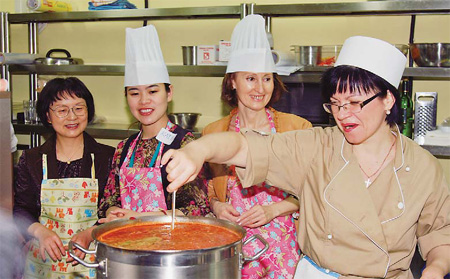From the Ukraine with love
 |
| Chef Alena Kolumbet demonstrates how to cook traditional borsch. |
There is a lot more than just simple ingredients that go into a bowl of borsch.
It's not just how you cook borsch that counts. It's how you feel when you cook it.
At least that's what Kiev-born chef Alena Kolumbet believes is the secret to the success of her traditional borsch, a watery red soup made with tomato, potato, beetroot, pork and dollops of sour cream. She serves it with garlic donuts, or bread steeped in a parsley-garlic sauce and flavored with egg.
"The secret to making good borsch is to make it with your soul," she said through a translator. "Your mood is very important. The person can feel this when they taste it. A good or bad mood is like the difference between eating homemade food or fast food. Scientific studies have been done to verify this."
Ukrainians eat the soup on an almost daily basis, slightly more so than in neighboring Russia, which also claims the dish as its own. The Ukrainian version differs by using fresh instead of sour cabbage, and more sour cream. It can be served hot or cold.
"I've eaten warm borsch in Russia but this one's different because it's cold. This is a little sweeter, but I like it," said Heike Heising of the Netherlands, sitting at a hand-carved wooden table. "Now (the weather is) hot, so I prefer this one."
The Ukraine Pavilion's outdoor latticework restaurant is so popular that even officials from the Russia Pavilion pop over to eat its borsch and drink its vodka regularly, waitresses claim.
Executive chef Kolumbet held a training day recently where she invited the wives of China-based consul-generals to learn how to cook the dish to perfection, a process that takes about 90 minutes. She showed them how to add kidney beans, green onions and seasoning, which, like other traditional ingredients, can be bought in Shanghai supermarkets.
"All our dishes are very healthy. The soups are good to eat in the afternoon and are good for your digestion. We try to oven-cook as much as possible instead of fry," said waitress Uliana Govoruha.
The restaurant offers 10 reasonably priced dishes. The most popular are the borsch (59 yuan), cutlets la Kiev (61 yuan) and chicken breast (80 yuan), which has bacon stuffed inside and is served with spicy carrot and rice.
Many are made with secret sauces that Kolumbet, who worked at the previous World Expo in Aichi, Japan, five years ago, is keeping tightly under wraps.
Unlike in Aichi, okroshka, another soup Ukrainians eat in summer, is off the menu, because the ingredients are too hard to find here. Kolumbet and her three chefs also decided to get rid of golubci, or pork wrapped in cabbage, after days of experimenting to see which dishes the Chinese liked.
In their place you can find veal medallion with eggplant; pork ribs with corn; and a new focus on desserts.
Dessert chef Aleksey Kurilenko has whipped up four treats from his native city of Donetsk to add to the tiramisu and cheesecake.
One desert, called Atlas, features a cream base sandwiched between two layers of white biscuit with chocolate shavings on top. It is so called because "the ingredients come from all over the world", he said.
You may encounter trouble ordering the Brown, a chocolate sponge cake with a chocolate biscuit base, "because the waitresses are always eating it", he said.
 0
0 







Go to Forum >>0 Comments